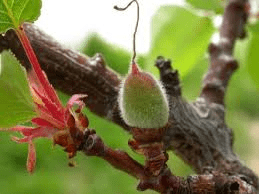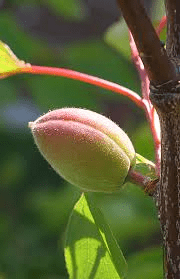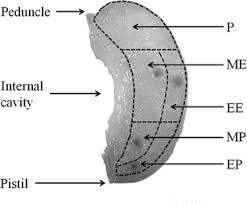The Apricot Peduncle in apricot trees (Prunus armeniaca) is the stalk that connects the flower or fruit to the main branch or twig of the tree. It plays a crucial role in supporting and nourishing the flower or fruit, facilitating the transport of nutrients and water from the tree to these structures.
Structurally, the peduncle is a slender, elongated stem that extends from the base of the flower or fruit to its attachment point on the branch. It is typically green and flexible when young, becoming more rigid and woody as it matures. The peduncle is covered by a layer of bark, which helps protect it from physical damage and environmental stresses.
During the flowering phase, the peduncle supports each flower, holding it in a position that maximizes exposure to pollinators. The length and strength of the peduncle can influence the flower’s ability to attract pollinators and receive adequate sunlight. In some apricot varieties, the peduncle may be relatively short, resulting in flowers that appear almost directly on the branch, while in others, it may be longer, allowing flowers to be more spaced out.
After pollination and fertilization, the peduncle continues to support the developing fruit. As the apricot fruit grows, the peduncle’s role becomes even more critical. It must withstand the weight of the enlarging fruit while maintaining its connection to the branch. The peduncle’s ability to transport nutrients and water from the tree to the fruit is essential for proper fruit development and ripening.
Healthy peduncles are vital for good fruit production. Any damage or stress to the peduncle can impact the flower’s ability to set fruit or the fruit’s ability to mature properly. For instance, diseases like bacterial canker or fungal infections can weaken the peduncle, leading to poor fruit development or premature fruit drop. Similarly, physical damage from pests or environmental conditions can affect the peduncle’s function.
Proper care and management of apricot trees can help ensure the health and effectiveness of the peduncle. Regular inspection of the branches and peduncles can help identify any signs of disease or damage early. Adequate watering, fertilization, and pest control are also important for maintaining the health of the peduncle and overall tree vitality.
In horticulture, the peduncle’s characteristics can sometimes be used to assess fruit quality and tree health. For example, a robust and well-developed peduncle typically indicates a healthy tree and good fruit development conditions. Conversely, weak or malformed peduncles may suggest underlying issues with tree health or growing conditions.
The peduncle is a crucial component of the apricot tree, serving as the connecting stem between the flower or fruit and the main branch. Its role in supporting, nourishing, and transporting nutrients is essential for successful flowering and fruit development. Proper care and management of the peduncle can contribute to the overall health and productivity of the apricot tree.
The Economic Importance and Uses of Apricot Peduncle

1. Horticultural Support: Apricot peduncles can be used as natural supports for young apricot trees and other plants, helping them grow straight and strong.
2. Crafting Material: The peduncles, or stems of apricot flowers, can be used in crafting projects to make decorative items, floral arrangements, and natural wreaths.
3. Mulch: Shredded apricot peduncles can be used as mulch in gardening, helping to retain soil moisture, suppress weeds, and improve soil fertility.
4. Composting: Apricot peduncles can be added to compost piles as a source of organic matter, aiding in the decomposition process and enriching the compost with nutrients.
5. Biomass Energy: Dried apricot peduncles can be used as biomass fuel, providing a renewable energy source for heating and other applications.
6. Soil Erosion Control: Peduncles can be used in soil erosion control practices, such as creating barriers or cover on slopes to prevent soil loss.
7. Animal Bedding: Chopped peduncles can be used as bedding material for livestock, providing a comfortable and absorbent surface.
8. Potpourri: Dried apricot peduncles are used in potpourri mixtures for their natural scent and texture, adding a rustic element to home décor.
9. Natural Fencing: Sturdy peduncles can be used to construct natural fences or garden trellises, offering an eco-friendly and durable fencing option.
10. Herbal Remedies: In traditional medicine, apricot peduncles are sometimes used in herbal remedies, believed to have beneficial properties for certain health conditions.
11. Educational Uses: Peduncles can be used in educational settings to teach students about plant anatomy, reproduction, and the role of flowers in plant life.
12. Decorative Art: Peduncles can be used in various forms of decorative art, such as making botanical prints, or creating natural sculptures.
13. Seedling Potting: Peduncles can be used in the creation of biodegradable pots for seedlings, providing an eco-friendly option for starting plants.
14. Eco-Friendly Packaging: Peduncles can be used in the creation of sustainable packaging materials, such as biodegradable fillers and cushioning for packaging.
15. Soil Improvement: Chopped peduncles can be mixed into soil to improve its structure and drainage, contributing to better plant growth.
16. Herbal Infusions: Peduncles are sometimes used in herbal infusions or teas, believed to have mild health benefits and adding a unique flavor.
17. Craft Supply: Peduncles can be used as part of craft supplies for making wreaths, garlands, and other handcrafted items.
18. Wildlife Habitat: Decaying peduncles can provide habitat and food sources for various wildlife, contributing to biodiversity in natural settings.
Read Also: Rose Chafer: Description, Damages Caused, Control and Preventive Measures
The Products and By-products That Can Be Derived From Apricot Peduncle

1. Horticultural Supports: Apricot peduncles are used as natural supports for young plants. They are placed in the soil to help plants grow upright.
2. Craft Items: Peduncles are used in crafting projects to make decorative items such as floral arrangements and wreaths. They are cut, shaped, and assembled into various crafts.
3. Mulch: Shredded apricot peduncles are used as mulch in gardens. They help retain soil moisture and suppress weed growth.
4. Compost: Chopped peduncles are added to compost piles. They decompose and contribute organic matter to the compost, enriching the soil.
5. Biomass Fuel: Dried peduncles are used as biomass fuel. They are burned to generate heat and energy.
6. Soil Erosion Barriers: Peduncles are used to create barriers on slopes to control soil erosion. They help stabilize the soil and prevent loss.
7. Animal Bedding: Chopped peduncles are used as bedding for livestock. They provide a comfortable and absorbent surface.
8. Potpourri: Dried peduncles are mixed with other aromatic materials to make potpourri. They add texture and a natural element to the mixture.
9. Natural Fencing: Sturdy peduncles are used to build natural fences and trellises. They are woven or placed to create durable and eco-friendly barriers.
10. Herbal Remedies: Peduncles are used in herbal remedies for their believed health benefits. They are prepared as teas or tinctures.
11. Educational Tools: Peduncles are used to teach students about plant anatomy and reproduction. They provide a hands-on learning experience.
12. Decorative Art: Peduncles are used in botanical art and natural sculptures. They are incorporated into various artistic creations.
13. Seedling Pots: Peduncles are used to make biodegradable pots for seedlings. They are shaped into pots that decompose and enrich the soil.
14. Packaging Materials: Peduncles are used as sustainable packaging fillers. They provide cushioning and reduce the environmental impact of packaging.
15. Soil Improvement: Chopped peduncles are mixed into soil to improve its structure and drainage, enhancing plant growth.
16. Herbal Infusions: Peduncles are used in herbal teas and infusions. They add a mild flavor and potential health benefits.
17. Craft Supplies: Peduncles are used in various craft projects, such as making garlands and natural decorations.
18. Wildlife Habitat: Decaying peduncles provide habitat and food for wildlife. They contribute to the ecological balance in natural environments.
Read Also: Maize Streak Virus: Description, Damages Caused, Control and Preventive Measures
Frequently Asked Questions (FAQ’s) About Apricot Peduncle

1. What are apricot peduncles used for in gardening?
Apricot peduncles are used as natural supports for young plants, helping them grow upright. They can also be used as mulch or added to compost piles to enrich the soil.
2. Can apricot peduncles be used in crafts?
Yes, apricot peduncles are used in crafting projects to make decorative items such as floral arrangements, wreaths, and natural art pieces.
3. How are apricot peduncles used as mulch?
Shredded apricot peduncles are spread around plants to act as mulch. They help retain soil moisture, suppress weed growth, and improve soil fertility.
4. Are apricot peduncles used in any medicinal applications?
In traditional medicine, apricot peduncles are sometimes used in herbal remedies believed to have health benefits for certain conditions.
5. Can apricot peduncles be used as fuel?
Yes, dried apricot peduncles can be used as biomass fuel. They are burned to generate heat and energy in various applications.
6. How do apricot peduncles help with soil erosion control?
Peduncles are used to create barriers on slopes to prevent soil erosion. They stabilize the soil and reduce runoff, helping to prevent soil loss.
7. Are apricot peduncles used in animal bedding?
Yes, chopped apricot peduncles are used as bedding material for livestock. They provide a comfortable and absorbent surface.
8. What is potpourri made from apricot peduncles?
Potpourri made from apricot peduncles includes dried peduncles mixed with other aromatic materials. They add texture and a natural element to the potpourri.
9. Can apricot peduncles be used for educational purposes?
Yes, apricot peduncles are used in educational settings to teach about plant anatomy, reproduction, and the role of flowers in ecosystems.
10. How are apricot peduncles used in eco-friendly packaging?
Apricot peduncles can be used as sustainable packaging fillers. They provide cushioning and reduce the environmental impact of packaging materials.
Read Also: The Impact Of Hazardous Waste Disposal in Los Angeles






